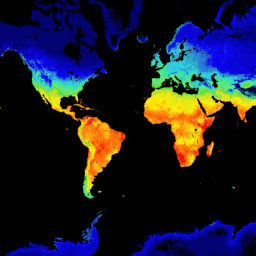
- 데이터 세트 제공
- 2021-11-29T00:00:00Z–2025-12-16T00:00:00Z
- 데이터 세트 제공업체
- Global Change Observation Mission (GCOM)
- 주기
- 1일
- 태그
설명
이 제품은 육지 표면의 온도입니다.
이 데이터 세트는 지연 시간이 3~4일인 지속적인 데이터 세트입니다.
GCOM-C는 향후 온도 상승에 관한 정확한 예측을 위해 필요한 복사 에너지 수지와 탄소 순환의 변동 뒤에 있는 메커니즘을 설명하기 위해 장기적이고 지속적인 전 세계 관측 및 데이터 수집을 수행합니다. 동시에 기후 수치 모델을 보유한 연구 기관과 협력하여 기후 수치 모델에서 파생된 온도 상승 예측의 오류를 줄이고 다양한 환경 변화 예측의 정확도를 개선하는 데 기여합니다. GCOM-C에 탑재된 SGLI는 ADEOS-II (MIDORI II)에 탑재된 Global Imager (GLI)의 후속 센서이며, 근자외선에서 열적외선 영역 (380nm~12μm)의 방사선을 19개 채널로 측정하는 이미징 방사계입니다. 지상 관측 폭이 1,000km 이상인 경우 일본 근처 중위도에서 약 2일에 한 번씩 전 세계 관측이 가능합니다. 또한 SGLI는 유사한 전 세계 센서보다 해상도가 높고 편광 관측 기능과 다각도 관측 기능이 있습니다.
대역
픽셀 크기
4638.3m
대역
| 이름 | 단위 | 최소 | 최대 | 픽셀 크기 | 설명 | ||||||||||||||||||||||||||||||||||||||||||||||||||||||||||||||||||||||||||||||||||||||||||||||
|---|---|---|---|---|---|---|---|---|---|---|---|---|---|---|---|---|---|---|---|---|---|---|---|---|---|---|---|---|---|---|---|---|---|---|---|---|---|---|---|---|---|---|---|---|---|---|---|---|---|---|---|---|---|---|---|---|---|---|---|---|---|---|---|---|---|---|---|---|---|---|---|---|---|---|---|---|---|---|---|---|---|---|---|---|---|---|---|---|---|---|---|---|---|---|---|---|---|---|---|
LST_AVE |
K | 0* | 65531* | 미터 | 지표면 온도입니다. |
||||||||||||||||||||||||||||||||||||||||||||||||||||||||||||||||||||||||||||||||||||||||||||||
LST_QA_flag |
미터 | LST QA |
|||||||||||||||||||||||||||||||||||||||||||||||||||||||||||||||||||||||||||||||||||||||||||||||||
이미지 속성
이미지 속성
| 이름 | 유형 | 설명 |
|---|---|---|
| ALGORITHM_VERSION | 문자열 | 알고리즘 버전 |
| GRID_INTERVAL | 문자열 | 공간 해상도 |
| GRID_INTERVAL_UNIT | 문자열 | GRID_INTERVAL의 단위 |
| IMAGE_END_TIME | 문자열 | 이미지 획득 종료 시간 |
| IMAGE_START_TIME | 문자열 | 이미지 획득 시작 시간 |
| PROCESSING_RESULT | 문자열 | 양호, 보통, 나쁨, NG |
| PROCESSING_UT | 문자열 | 처리 시각 |
| PRODUCT_FILENAME | 문자열 | 소스 파일 이름 |
| PRODUCT_VERSION | 문자열 | 제품 버전 |
| SATELLITE_DIRECTION | 문자열 | 위성 궤도 방향
|
| LST_AVE_OFFSET | 문자열 | 오프셋 |
| LST_AVE_SLOPE | 문자열 | 경사도 |
이용약관
이용약관
이 데이터 세트는 상업적 사용을 비롯한 제한 없이 무료로 사용할 수 있습니다. 분석된 결과나 부가가치 데이터 제품을 게시하려는 사람은 원래 G-Portal 데이터를 적절하게 인용해야 합니다.예를 들면 다음과 같습니다. '일본 항공우주탐사국에서 제공한 PR 데이터' 부가가치 데이터 제품의 경우 원본 G-Portal 데이터의 출처를 표시하세요(예: '이 부가 가치 데이터 제품의 원본 데이터는 일본 항공우주탐사국에서 제공했습니다.'
자세한 내용은 G-Portal 서비스 약관 (7조)을 참고하세요.
인용
Moriyama, M. (2020년 5월). GCOM-C1/SGLI 지표면 온도 제품 알고리즘 이론적 근거 문서 (버전 2). https://suzaku.eorc.jaxa.jp/GCOM_C/data/ATBD/ver2/V2ATBD_T4A_LST_Moriyama_r1.pdf에서 가져옴
Earth Engine으로 탐색
코드 편집기(JavaScript)
var dataset = ee.ImageCollection('JAXA/GCOM-C/L3/LAND/LST/V3') .filterDate('2021-12-01', '2022-01-01') // filter to daytime data only .filter(ee.Filter.eq('SATELLITE_DIRECTION', 'D')); // Multiply with slope coefficient var dataset = dataset.mean().multiply(0.02); var visualization = { bands: ['LST_AVE'], min: 250, max: 316, palette: [ '040274','040281','0502a3','0502b8','0502ce','0502e6', '0602ff','235cb1','307ef3','269db1','30c8e2','32d3ef', '3be285','3ff38f','86e26f','3ae237','b5e22e','d6e21f', 'fff705','ffd611','ffb613','ff8b13','ff6e08','ff500d', 'ff0000','de0101','c21301','a71001','911003', ] }; Map.setCenter(128.45, 33.33, 5); Map.addLayer(dataset, visualization, 'Land Surface Temperature');
